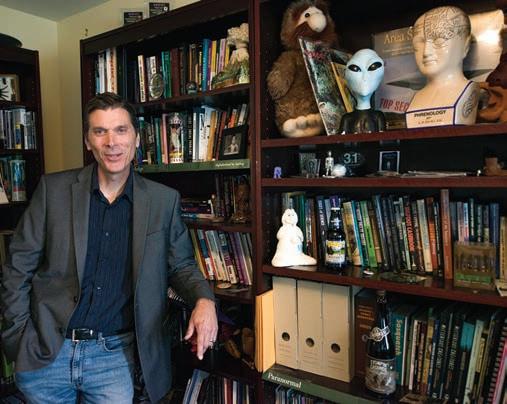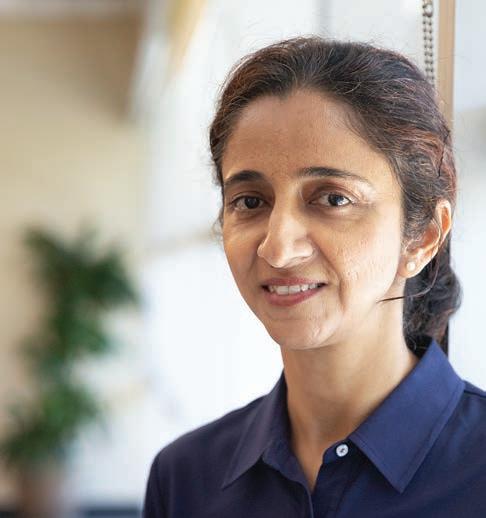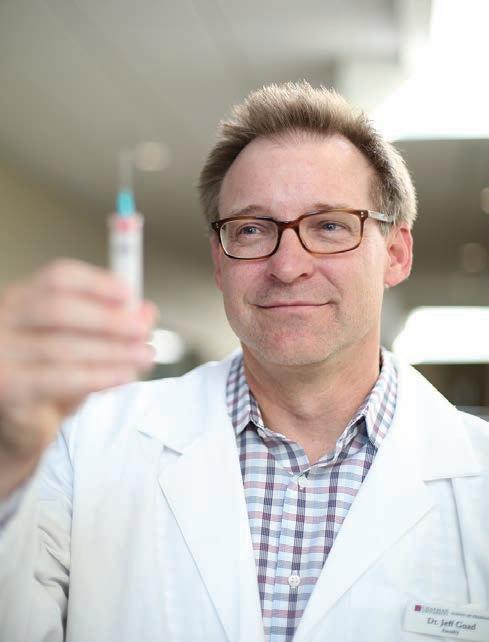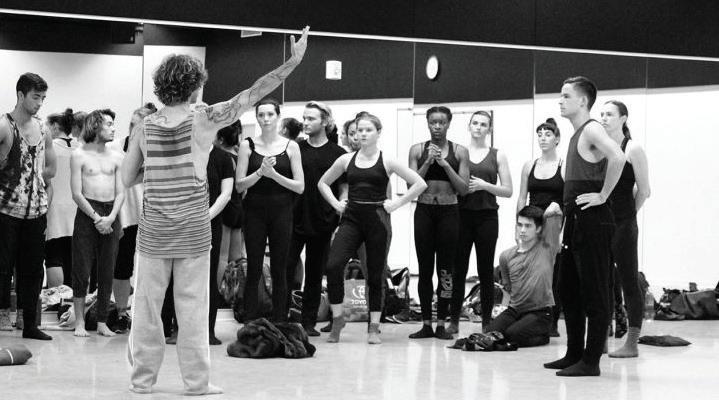
30 minute read
Christopher Bader’s study of paranormal belief reveals a shift toward faith in the personal experience
WHY IS PARANORMAL BELIEF ON THE RISE?

Advertisement








BY BRITTANY HANSON

PHOTOS BY DENNIS ARP
RESEARCH REVEALS A SIGNIFICANT SHIFT AWAY FROM STRUCTURED SYSTEMS TOWARD FAITH IN THE PERSONAL EXPERIENCE.

Bigfoot, aliens, ghosts and psychic abilities used to be the stuff of checkout-line tabloids and daytime TV. But now these, and many more beliefs like them, are securing a spot in the mainstream. ”Belief in the paranormal is no longer a fringe subject,“ says Christopher Bader, Ph.D., Chapman research professor and author of ”Paranormal America.“
A majority of Americans – 52% and rising – profess to having a paranormal belief or experience. A re belief systems becoming more “out there,” or does this rise in acceptance of the paranormal tell us something larger about a shift in how people come to develop their beliefs? This is the compound question Chapman University research professor Christopher Bader, Ph.D., sought to investigate in his book “Paranormal America: Ghost Encounters, UFO Sightings, Bigfoot Hunts, and Other Curiosities in Religion and Culture.” “Belief in the paranormal is no longer a fringe subject,” says Bader, who co-leads Chapman’s Institute for Religion, Economics and Society with professors Ann Gordon, Ph.D., and Edward Day, Ph.D. The three are principal investigators on the annual Chapman University Survey of American Fears. Bader has published widely on paranormal experiences, fear, sociology, deviance, criminology, the sociology of religion and education. He has embedded with Bigfoot hunts, talked with UFO encounter support groups and gone on and organized ghost hunts. The research for “Paranormal America” pulls information from five survey projects that involve Bader, drawing from a combined survey set of more than 4,000 respondents. The research shows that the trend toward paranormal beliefs and experiences embraces a broad pantheon of ideas. Some believers in the paranormal search the skies for unexplained lights, go on late-night hunts for ghosts or hike through North American woods in search of Bigfoot. Some believe in the lost city of Atlantis, demon possession, prophetic dreams, reiki, healing sounds, power crystals and tarot cards. The intensity of belief also varies widely. THE PARANORMAL IS PERSONAL One commonality is that people don’t like it when others tell them what to believe, Bader says. “They’re hearing, ‘Here’s what God is, here’s what God wants, here’s what God says is right and wrong.’ If you walk into your church and you say, ‘I’m seeing a ghost,’ they can say, ‘No you didn’t,’ and that’s it,” Bader says. These days, Bader’s research reveals that people are less likely to let outside forces dictate their beliefs. The shift from institutional to personal belief structures could be one reason for the rise in the reports of paranormal experiences, he says. With the paranormal, Bader notes, things are extremely democratic, except as they affect atheists and the intensely religious. These groups are the least likely to report paranormal beliefs or experiences. “It’s because they’re convinced it’s something else,” Bader says. Each of these groups has a strictly bound belief system already in place, he adds. Research indicates that people tend to focus on a particular area of paranormal interest based less on what they know and more on what they feel or see. “The paranormal is about people who have experienced something,” says Bader. “The people who are the most into it are the people who have experienced it for themselves.” SURVEY FINDINGS Professor Bader’s research shows that… 25% of Americans have read or researched the world of ghosts, hauntings and apparitions. MEN are more likely to connect with the paranormal via cryptozoology, or animals of folklore (Bigfoot, the Loch Ness Monster, the Chupacabra). WOMEN are more drawn to New Age connections (psychics, mediums, astrology, ghost contact).
67.9% of women respondents
63.3% of male respondents
59.1% of women respondents
52.1% of male respondents
MARRIED = UNMARRIED
Concentrating the Power of Cancer-Killing Drugs

BY DAWN BONKER

Pharmacy researcher Kamaljit Kaur engineers a targeted therapy that spares healthy cells.
Kamaljit Kaur, Ph.D.
Triple-negative breast cancer is a perfect storm of challenges for both patient and physician. It generally strikes women under 40, spreads beyond the breast and reoccurs after treatment. Unlike other varieties of cancer, it isn’t driven by hormones, so the one-two punch of chemotherapy partnered with newer therapies that target hormone-sensitive tumors isn’t an option. Hence, chemotherapy is the linchpin of treatment against this particularly aggressive disease, which strikes African American women and Latinas and carriers of BRCA gene mutations in disproportionate numbers. A scientist at Chapman University School of Pharmacy is working to improve how those powerful cancer-killing drugs reach their targets, potentially increasing survival rates for millions of women while easing the abysmal side effects of treatment. Her work is so promising that it earned a three-year, $400,000 grant from the NIH-National Cancer Institute on which Kamaljit Kaur is the principal investigator. “It’s a very simple idea, really. I’m not doing any fancy laser treatment or radiation. This is just using existing chemotherapy, but making it much better – many times better,” says Kaur, Ph.D., director of the Center for Targeted Drug Delivery and associate professor at Chapman.
In essence, Kaur has engineered a kind of molecular radar system and attached it to the therapeutic drugs. Working in her lab with sophisticated robotics and software, she reassembles selected peptides drawn from amino acids contained in larger proteins. The result is a cancer-cell-targeting (binding) peptide. When connected to medication molecules, this structure helps the chemotherapy agent travel intact until it meets cancer cells. That encounter triggers the peptide to attach to the cancer cells, unleashing the tumor-killing payload where it’s needed, rather than throughout the body. Sparing healthy cells the ravages of chemotherapy is just one reason targeted drug delivery systems like Kaur’s are a rising area of interest in cancer research. “These chemotherapy drugs are beautiful,” Kaur says. “They are very powerful, and their mechanisms of action are highly effective in combating cancer. However, when they are not targeted, they wreak havoc on ‘good’ cells, and that is the main problem of conventional chemotherapy. If these drugs can be targeted, they could be signifi cantly more potent in fi ghting carcinogenic cells.” In the case of triple-negative breast cancer, targeted therapy could also allow for more intense treatment, often the key to battling this cancer. Many patients can’t tolerate elevated amounts of the potent drugs, though, so doctors are forced to reduce the level of treatment, which can lower cure rates or lead to the development of drug resistance, Kaur says. But if engineered peptides prove workable, the breakthrough could be transformational. “It is a win-win situation, if it works,” she says. Kaur and her collaborators at the City of Hope are still testing the engineered peptide-drug conjugates, also known as PDCs, in mice and say it’s too soon to report even early fi ndings. But results Kaur published in the Journal of Medicinal Chemistry showed that PDCs prepared in her laboratory were four times more effective against drug-resistant cancer cells than the drug itself. That promising direction excites Kaur, who is hopeful such work will contribute to other areas of cancer research. The fi eld captured her attention when she was in graduate school, and like so many people, family members have been touched by the disease. “Cancer is a very diffi cult problem to address, and I thought I should probably understand one form better, and then we can go to others,” she says. “So, I'm focusing on breast cancer to basically learn as much as I can. Then, my research can potentially be applied to any other cancer.”
Working in her lab, Professor Kaur reassembles selected peptides drawn from amino acids contained in larger proteins. The result is a binding peptide that can attach to cancer cells, unleashing a tumor-killing payload where it's needed. Photo by Gerald Carter
Kamaljit Kaur, Ph.D., director of the Center for Targeted Drug Delivery at Chapman.
CALIFORNIA FEUDALISM: THE SQUEEZE ON THE MIDDLE CLASS
This essay is excerpted from a research brief published by the Center for Demographics and Policy at Chapman University. The full report is at chapman.edu/wilkinson/_files/Feudalism.pdf.
BY JOEL KOTKIN AND MARSHALL TOPLANSKY
California was built by people dedicated to hard work, innovation, family and community. A large number came from other countries or poor backgrounds: sharecroppers from the South, campesinos from Mexico, people fleeing communism and poverty in Asia, escapees from Hitler’s Europe, or Okies and others fleeing the Dust Bowl.
This proud legacy is threatened. California has now taken on an increasingly feudal cast, with a small but growing group of the ultra-rich, a diminishing middle class, and a large, rising segment of the population that is in or near poverty. Indeed, amid some of the greatest accumulations of wealth in history, California has emerged as a leader in poverty. Adjusted for costs, California’s overall poverty rate is the highest in the country, according to the U.S. Census Bureau.
The most fundamental threat to the middle class in California lies with the state’s extremely high cost of living, which has largely been caused by unprecedented house price increases relative to household incomes. More than 80% of the higher cost of living in California is the result of higher housing costs. What is the impact of rising costs on everyday Californians? We set out to answer this question by looking at the real-world household finances of different groups within the state. Our Chapman University research team identified eight broad California “personas” that we can all relate to. We looked at diverse groups of people who vary by whether they live inland or on the coast, by age, by how many children they are raising, and by income level.
Our goal was to answer a simple question: How much income do people have after paying taxes and the essential expenses required for a reasonably expected standard of living at their income level? The answers raise deep concerns about the sustainability of the California Dream. To a remarkable extent, Californians simply cannot afford the expenses necessary to support the standard of living expected at their income level. This has consequences that affect expenditures and lifestyle. Californians with above-average incomes might underfund their savings. Retirees might cut back on healthcare and transportation spending. Lower-income people might share housing costs with other households. Households with children might avoid costly childcare by relying on friends or relatives, or even leaving older children unsupervised.
Many Californians turn to consumer debt to plug the gap. Data from the Federal Reserve Bank of New York on non-mortgage debt shows that Californians have increased their percentage of after-tax income dedicated to consumer debt service to close to what it was at pre-recession levels. This has forced many people into lower standards of living and heavy borrowing to survive financially. We examined the pre-tax incomes, the spending habits necessary to support a reasonably expected standard of living, and the resulting hypothetical surpluses or deficits in eight cases, which we call personas.
Our results are based on statistics published by broad data collection sources, such as the MIT Cost of Living Calculator and the Bureau of Labor Statistics (BLS) Consumer Expenditure Survey. We also used secondary research on specific areas of expenditure from topic-specific
PERSONA PRE-TAX INCOME PERCENTILE 2018 PRE-TAX HH INCOME 2018 HYPOTHETICAL SURPLUS (DEFICIT) HOUSING,UTILITIES AND PROPERTY TAXES (IF OWN) TRANSPORTATION 2018 HYPOTHETICAL SURPLUS/DEFICIT AS % OF AFTER-TAX INCOME
Upper Management and Professionals 99% $500,000+ $78,073+ 42% 7% 27%
Recent Professional Degree
40% $47,000 ($21,017) 60% 26% -53%
Experienced Manufacturing Worker
40% $47,000 ($11,358) 36% 26% -29%
sources. Finally, we incorporated interviews with individuals and families about expense levels they are experiencing in the real world. We placed greater weight on these “real world” numbers. The accompanying chart shows the percentage of after-tax income each spending category represents for each of the different personas. Only two of the personas would have enough income for their expected standard of living: the upper 1%, and recent college graduates with professional degrees and without children to support.
For our other personas, hypothetical spending exceeds after-tax income from 1% (for midlevel executives with $230,000 in pre-tax household incomes) to 53% for coastal service line workers. Six of the eight personas have negative hypothetical income, which can be as high as $21,017 for lower income coastal service workers. Housing, not surprisingly, is the highest expense for all personas, ranging from 70% of after-tax income for retirees to 36% for lower income people who share household expenses with other families. Transportation is the next highest expense, as a percentage of aftertax income, for most others.
Using our rough estimates, it appears that many Californians have a deficit every month relative to the expected standard of living. Many often simply “do without.” Increasingly little of California’s population is “living the dream;” even fewer are living it without financial anxiety.
Joel Kotkin is the RC Hobbs Presidential Fellow in Urban Futures at Chapman University and the director of Chapman’s Center for Demographics and Policy. Marshall Toplansky is clinical assistant professor of management science at Chapman’s Argyros School of Business and Economics and research fellow at the Hoag Center for Real Estate and Finance.
TAXES, GUNS AND SUICIDE: AN ECONOMIST’S UNEXPECTED JOURNEY
This piece was first published in the Los Angeles Times.
BY JAMES L. DOTI
James L. Doti, Ph.D., is an economics professor and president emeritus of Chapman University. He founded the Anderson Center for Economic Research in 1978 and continues to serve as one of its lead researchers and presenters of the University’s annual Economic Forecast. The fascinating thing about economic research is that it moves in ways that often can’t be anticipated. Sometimes, your assumptions are upended.
I was recently part of a research team that showed that people living in states with relatively high taxes tended over time to move to states with lower taxes. Case in point: The states with the highest rates of taxation — New Jersey, California and New York — also had the highest levels and rates of net outward migration.
In the course of that research, I came across statistics that showed New Jersey, California and New York as having the three lowest rates of suicide. How could it be that the three states with the highest tax rates also had the lowest suicide rates?
Perhaps higher taxes allowed for greater funding levels for suicide prevention or mental health programs. Or more likely, I thought, this was simply a spurious relationship and there was something else going on that explained suicide rates. But what was that “something else”?
My eureka moment came when further research revealed that high-tax states like New Jersey, California and New York were among the lowest in rates of gun ownership. At the same time, states like Montana, South Dakota and Wyoming had something else in common besides low tax rates. They also had high rates of gun ownership.
Half of all suicide deaths are caused by firearms. Over the last decade, the number of U.S. suicides by firearm has increased almost 20%, claiming the lives of nearly 22,000 Americans every year. Suicide is now the 10th leading cause of death in the U.S.
So maybe the “something else” that explains the number of suicides is not the rate of taxation but the more intuitively plausible connection with gun ownership.
To test that, I measured the correlation between the percentage of American adults over 18 who owned guns and the number of suicides per 100,000 individuals over 18 for all 50 states. That correlation was not only statistically significant but higher than the correlation between taxes and suicides.
For example, 20% of adults in California own a gun, vs. Arizona’s 32%. Given the close relationship I measured for the correlation between gun ownership and suicide for all 50 states, it shouldn’t be surprising that California’s suicide rate of 10.5 per 100,000 individuals was lower than Arizona’s 18.2 per 100,000.
I also found that the 12 states with the highest rates of gun ownership had an average suicide rate of 20 per 100,000 individuals. By contrast, the 12 states with the lowest rates of gun ownership had a significantly lower suicide rate of 12.3 per
100,000. Even more alarming was that the 12 states with the highest rates of gun ownership also had the highest teen suicide rate of 16.6 per 100,000 adolescents ages 15 to 19. That teen suicide rate is roughly double the 8.0 rate for the 12 states with the lowest rates of gun ownership.
I also ran regression tests that suggested if tougher gun regulations were to push gun ownership from its current average of 33% of all adults over 18 to, say, a lower rate of 29%, the projected number of suicides would decline from the current average of 16.7 suicides per 100,000 individuals to 15.7 suicides per 100,000. Such a decrease would lead to about 3,000 fewer suicides nationwide a year.
It might be argued, though, that if guns weren’t around, suicidal people would find other ways to commit their act. But if this were the case, one would expect states with low rates of gun ownership to have higher rates of non-firearm suicide and vice versa. Such an inverse relationship, however, was not supported in the correlation and regression tests I conducted.
When a gun is more readily available, there is a greater likelihood that it will be used to commit suicide. Other studies have shown that many suicide attempts are impulsive acts. That, in turn, suggests that if a gun is more accessible, it will be easier to act on impulse.
What started out for me as a question about a seemingly inexplicable relationship between taxes and suicides eventually led to compelling findings about the relationship between guns and suicides.
”How could it be that the three states with the highest tax rates also had the lowest suicide rates? My eureka moment came when further research revealed that high-tax states like New Jersey, California and New York were among the lowest in rates of gun ownership.“
Jim Doti
CALIFORNIA
ARIZONA GUN OWNERSHIP
20% OF ADULTS
32% OF ADULTS
12 STATES W/ LOWEST GUN OWNERSHIP
12 STATES W/ HIGHEST GUN OWNERSHIP SUICIDE RATE*
12.3
20
SUICIDE RATE*
10.5
18.2
*PER 100,000
TEEN SUICIDE RATE*
8
16.6
*PER 100,000
?Quelling The Fears That Prevent Vaccination 5 QUESTIONS

BY DAWN BONKER
Scientists, decades of authoritative research, the Centers for Disease Control and Prevention, generations of physicians and more than a few grandparents who remember the dangers of childhood diseases all agree on this fact— immunizations save lives.
And yet, a U.S. measles outbreak that began this winter endures and is linked to a growing number of parents who reject vaccinations for their children. This fall, seasonal flu shots again will be offered at multiple locations, from supermarkets to work places, and yet only an estimated 37 percent of American adults will roll up their sleeves, despite the vaccine’s proven ability to prevent flu.
What’s going on here? In a nutshell, it’s more about social science than medical science, says Jeff Goad, Pharm.D., professor and chair of the Department of Pharmacy Practice at the Chapman University School of Pharmacy. Goad is past president of the California Immunization Coalition, winner of 2019 APhA Immunization Champion Award for Outstanding Career Achievement and a frequent lecturer on vaccination awareness and education.
Why do people think they know better than what research has proved? We’ve had a mistrust of government that’s been percolating from the 1960s and on for a range of things, from supposed conspiracy theories to government cover-ups. It used to be that the media would investigate those kinds of stories and they’d be vetted, filtered and examined through a much more objective lens. Today there is no filter and there is no lens. The Internet can send you five different takes on the same story. It’s information overload for many people. The Centers for Disease Control becomes just one more voice. The cycle is so quick, the legitimate media sometimes get outpaced. People don’t know the difference between a CNN story and a parent blog.
How do health educators combat this trend? We think about it on a spectrum. You have the vaccine-compliant, who come in asking for vaccines and follow recommended guidelines. At the opposite end of the spectrum, you have the anti-vaccination groups. You’re going to make little to no headway with them. We actually try not to engage them. But what gets wrapped in the middle is what we call the vaccine-hesitant. That’s the group we need to work with. The vaccine
Since measles is highly contagious, even a small number of unvaccinated children can trigger an outbreak, says Chapman Professor Jeff Goad, Pharm.D., an immunization expert.
hesitant are moms and dads who’ve heard something on a talk show or read something on the Internet that makes them hesitant to vaccinate their child. But when you meet them where they are and present them with the facts, they usually choose vaccination. Fortunately, there are more people who get vaccinations for their children than not.
If most are vaccinated, why are unvaccinated children a problem? Since measles is highly contagious, even a small number of unvaccinated kids can set off an outbreak. For example, a child with measles will infect around 12 to 18 non-immune people, who can then infect 12 to 18 more, and on it goes. If you increase the number of vaccinated (considered immune), that child with measles just has less people to pass it on to, and eventually the disease runs its course before they can infect anyone else.
What educational approaches work well? I’ve worked with many different groups on this, from the Centers for Disease Control to the Immunization Action Coalition and lots of community-based groups. The universal theme is “fight fire with fire.” For example, since the anti-vaccine group uses personal stories to distort the facts, our immunization coalition created a series of videos of parents whose kids and other loved ones have been injured by the diseases that could have been prevented through immunization.
What makes this approach effective? It’s difficult to relate to just numbers. Anytime you’re talking numbers, you must have a story with it–something they can contextualize, otherwise the message is not going to stick. Telling people that the flu killed almost 80,000 people in the U.S. last year, as amazing as that sounds, is not as powerful as showing a story of a mom recalling when she lost her little girl to what she thought was a cold but turned out to be influenza.
$1.6M GRANT FUNDS STUDY OF CANCER-RELATED VIRUS
BY DAWN BONKER
A professor at the Chapman University School of Pharmacy has received a $1.6 million grant from the National Institutes of Health (NIH) to study Kaposi sarcoma-associated herpesvirus, which can cause cancer and other diseases, particularly in transplant recipients and people with HIV infections.
Jennifer E. Totonchy, Ph.D., will use the RO1 grant to better understand how the virus is transmitted, interacts with the human immune system and is affected by other factors.
RO1-level grants are one of the NIH’s largest funding mechanisms, and they support significant health-related research for up to five years. This is the first Chapman -submitted R01 grant for the School of Pharmacy, which opened its doors to students just five years ago.
“This is a testament to Jennifer’s scientific prowess and the incredible, dedicated work of her and her laboratory team and collaborators,” said Ron Jordan, Pharm.D., dean of the School of Pharmacy.
The National Cancer Institute at the NIH is interested in the virus’ transmission paths because scientists do not yet understand how the virus causes cancer. So prevention is paramount, Totonchy says.
“We’ve known about the virus for about 25 years, and we still do not know how it moves around in the human population. This research is based on the idea that if we know how this virus gets from person to person, we might be able to rationally design strategies to prevent that from happening and therefore prevent cancer from happening in the first place.”
“Limiting the spread is the easier way of getting rid of the cancers that are associated with this virus,” she says. Professor Jennifer E. Totonchy is studying how Kaposi sarcomaassociated herpesvirus is transmitted.

With this new grant, Totonchy will use a variety of cell types collected from human tonsils to identify factors that influence transmission of the virus. It also will build on her ongoing research into how the virus influences B cells in tonsil tissue.
The research potentially holds other implications, too. Many scientists who study viruses suspect inflammation may help organisms gain a foothold, so the findings may add pieces to the inflammation puzzle, she says.
“Inflamed tissue is probably pretty relevant to transmission,” Totonchy says. “There are epidemiological studies suggesting that for some reason this virus really does better in an inflamed context, which seems like it would have implications for the study of inflammation in general.”
Biological sciences student Alex Drivas ’21, left, talks with Carter Berry, Ph.D., about equipment Drivas helped design to advance Berry’s plant research. Photo by Dennis Arp.

Chapman University researcher Carter Berry seeks to understand how diverse forests are faring in an unprecedented era of climate change. While many scientists are studying plant photosynthesis in hot, sunny conditions, Berry is looking at what happens when clouds predominate.
The lecturer and postdoctoral fellow teaches in Chapman’s Grand Challenges Initiative, which assembles teams of undergraduate students to take on some of the most pressing problems of our time, from ensuring a cybersecure future to curing a neurodegenerative disease.
To date, Grand Challenges Fellows have submitted more than 20 articles to peer-reviewed publications and have authored $750,000 in federal and foundation grant proposals.
Berry’s research has yielded two well-received publications, including an August 2019 article in New Phytologist. Through the Grand Challenges Initiative, Berry has welcomed undergraduate students into his research project, which explores the fundamental ways plants function and take in carbon in low light and wet conditions.
Among the participating students is biological sciences major Alex Drivas ’21, who has developed designs and 3D printed next-generation equipment to advance the research.
“We want our students to learn from world-class scholars who are engaging in creative ways of thinking about our world,” says Greg Goldsmith, Ph.D., assistant professor of biological sciences and director of the Grand Challenges Initiative. “Carter is the perfect example of how mentors can empower students to use science, technology, engineering and mathematics to change the world around them.”
FEDERAL FUNDING RENEWED FOR LIFESPAN DEVELOPMENT STUDY
Laura Glynn, Ph.D., has received a five-year renewal of federal funding for her research on child development, maternal connection and mental health, with the grant support coming from the National Institute of Mental Health.
About $3.9 million of an overall $15 million multiuniversity grant, led by the University of California, Irvine, will go to support Glynn’s research, which includes postpartum depression and factors related to the mother-child bond.
For nearly 20 years, Glynn, a professor of psychology at Chapman University, has been involved in a longitudinal study funded by a number of agencies, including the National Institute of Child and Human Development. Glynn leads Chapman’s Early Human and Lifespan Development Research Program. Children in the study range in age from early childhood to early adulthood. The second wave of the research will focus on mental health and anhedonia, which is the inability to experience pleasure from activities that are usually found enjoyable.
Glynn’s research will utilize cutting-edge neuroimaging data and also examine epigenetics –c hanges in the structure of genetic expression that can occur when someone has been exposed to long-term or chronic stress.

The overall goal of the long-term study is to understand how prenatal and early life experience influences lifespan mental health trajectories.
STUDENTS EXPLORE ISRAEL’S CONTEMPORARY DANCE SCENE
The world of dance grew a little bigger for Chapman University students during a 10-day summer travel course in Israel, where they immersed themselves in the nation’s vibrant modern dance culture.
The group was accompanied by the world-renowned Israeli dancer Ido Tadmor, who is a Presidential Fellow in Chapman’s College of Performing Arts. Tadmor teaches master classes, provides feedback to choreographers and develops original work for performances during his multiple visits to Chapman each year.
"Israel is a world leader when it comes to contemporary dance,” said Julianne O’Brien, Department of Dance chair, who led the travel course along with Associate Professor Liz Maxwell. “We wanted to give our students the opportunity to learn from these emerging companies and performers.”
After weeks of preparation that included in-depth reading on dance theory, the dancers traveled throughout Israel, taking in historic sites while also participating in daily classes and rehearsals with some of the top dance companies in the country, including Kibbutz Contemporary Dance, Batsheva and Vertigo Dance Company.
“It was the most incredible opportunity to dive into the exciting things happening in modern dance in Israel,” said Sophia Barr ’21, a student participant. “We challenged ourselves daily with intense repertoire and movement exploration.”
"Being in a place of such rich history and vibrance as Tel Aviv established a beautiful contrast,” said Maddie Miler ‘21. “It felt as if the city was encouraging the inner artist in me to grow and discover who I am as an individual."

Photo by Troy Nikolic.

ADVISING NIXON: THE WHITE HOUSE MEMOS OF PATRICK J. BUCHANAN (University of Kansas Press) Lori Cox Han, Ph.D., professor of political science The copious memos produced by Buchanan, counseling President Richard Nixon on press relations, policy positions and political strategy, provide a remarkable look inside the workings of the Nixon White House – and a perspective on practices that forever changed presidential conduct and U.S. politics.
MICROCREDIT MELTDOWN: THE RISE AND FALL OF SOUTH SUDAN'S POST-CONFLICT MICROCREDIT SECTOR (Lexington Books) Crystal Murphy, Ph.D., assistant professor of political science and director of M.A. in International Studies Program This account of the ambitious launch and premature downfall of the Southern Sudanese microcredit industry shows how the ideological and material constraints of the commercial microcredit paradigm were woefully misaligned with local socio-cultural realities.
HUMANOMICS: MORAL SENTIMENTS AND THE WEALTH OF NATIONS FOR THE TWENTY-FIRST CENTURY (Cambridge University Press) Vernon Smith, Ph.D., George L. Argyros Endowed Chair in Finance and Economics, and professor of economics and law; Bart J. Wilson, Ph.D., professor, Donald P. Kennedy Chair in Economics and Law, and director of the Smith Institute for Political Economy and Philosophy Smith and Wilson show how Adam Smith's model of sociality can re-humanize 21st-century economics by supporting it with sentiments, fellow feeling and a sense of propriety – the stuff of which human relationships are built. THE PECULIAR INSTITUTION AND THE MAKING OF MODERN PSYCHIATRY, 1840–1880 (The University of North Carolina Press) Wendy Gonaver, Special Collections & Archives assistant in Leatherby Libraries Gonaver reveals how slavery infl uenced ideas about patient liberty as well as the proper relationship between caregiver and patient. The book fi lls an important gap in the historiography of mental health and race in the 19th century.
MACHINE LEARNING AND DATA MINING IN AEROSPACE TECHNOLOGY (Springer) Editors: Hesham El-Askary, Professor of Remote Sensing and Earth System Science, Center of Excellence in Earth Systems Modeling and Observations; Aboul Ella Hassanien; Ashraf Darwish This work considers central problems in the health monitoring of artificial satellites. It also addresses telemetry data analytics and mining problems and focuses on security issues in telemetry data.
SENECA LAKE (The Wild Rose Press) Emily Heebner, lecturer on acting in the College of Performing Arts This young adult WWII novel tells the story of an unexpected romance as a teenager pursues a dream of attending college despite her grandparents' wishes that she stay home and get married.
THE MARKETING EDGE FOR FILMMAKERS: DEVELOPING A MARKETING MINDSET FROM CONCEPT THROUGH RELEASE (Routledge/Focal Press) Russell Schwartz, associate professor of film; Katherine MacDonald Written for working and aspiring filmmakers, the book walks through every stage of the marketing process and illustrates how creative decisions at each stage impact the marketability of a film.
PRODUCTION DESIGN: VISUAL DESIGN FOR FILM AND TELEVISION (Routledge/ Taylor & Francis Group/ Focal Press) Peg McClellan, instructor of film The book covers three major areas, starting with an overview and the basics of job responsibilities, the artistic approach and the background which every Production Designer needs to be familiar with, and progressing to the mechanics of the role with a day-to-day breakdown of the job itself. McClellan takes readers through script analysis, team collaborations, the hierarchy of a production, hiring a team, the business elements, locations, studio facilities, handling change and everything in between. A REVOLUTIONARY SUBJECT: PEDAGOGY OF WOMEN OF COLOR AND INDIGENEITY (Peter Lang Inc., International Academic Publishers) Lilia Monzó, Ph.D., associate professor of education This book serves as a call to radical educators and grassroots organizers to recognize the enormous historical legacy of women of color and indigeneity. It highlights a class struggle that is anti-racist, anti-sexist and against all forms of oppression.
BREAKING FREE: THE LIFE AND TIMES OF PETER MCLAREN, A RADICAL EDUCATOR (Myers Education Press) Peter McLaren, Ph.D., Distinguished Professor in Critical Studies and co-director of the Paulo Freire Democratic Project Illustrated by Miles Wilson (MFA ’19) This book chronicles McLaren’s cross-country climb up the educational ladder as a teacher steeped in the school system. Included are his encounters with various key players in history, from the Black Panthers to Timothy Leary.
PRE-EARTHQUAKE PROCESSES: A MULTI-DISCIPLINARY APPROACH TO EARTHQUAKE PREDICTION STUDIES (John Wiley & Sons) Dimitar Ouzounov, Ph.D., associate professor of physics; Sergey Pulinets; Katsumi Hattori; Patrick Taylor Published by the American Geophysical Union, this work explores different signals that have been recorded prior to some earthquakes and the extent to which they might be used for forecasting or prediction.
33% increase
$11.7 M $14.1 M
38% increase
$4.06 M $5.62 M
Research expenditures (FY17 - FY18) Federal research expenditures 107% increase 24% increase
$10.3 M $21.3 M
Awards
171 212
Number of Proposals
Other Numbers of Note
348
Doctorate degrees (DPT, JD, Ph.D., Pharm.D.) conferred in 2018-2019.
28%
Percentage of students who work with a faculty member on a research project
5
Number of individual awards in FY2019 greater than $1 million
5
Number of new faculty members in the Million Dollar Club, recognizing those who have received more than $1 million in external support for their research.
$7M
Amount of the largest non-federal award granted to Chapman this past year, by the Fetzer Institute and the John Templeton Foundation.
One University Drive Orange, California 92866 Chapman.edu
WHERE RESEARCH AND TEACHING INTERSECT.








